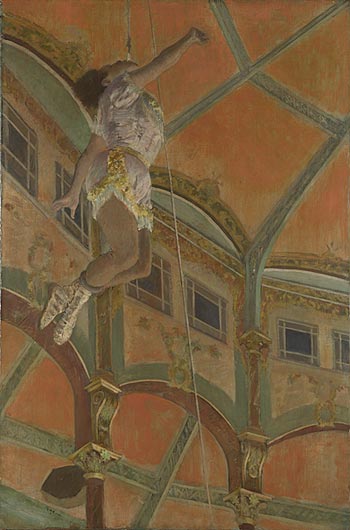
Edgar Degas, “Miss La La at the Cirque Fernando,” oil on canvas, 1879, (© National Gallery, London / Art Resource, NY)
Morgan Library & Museum
225 Madison Ave. at 36th St.
Through May 12, $10-$15
212-685-0008
www.themorgan.org
The arrival of Edgar Degas’s lovely 1879 painting “Miss La La at the Cirque Fernando” on these shores is reason enough to cheer. But curator Linda Wolk-Simon has taken the canvas, on loan from the National Gallery in London, and made it the focus of the wonderful exhibit “Degas, Miss La La, and the Cirque Fernando,” continuing at the Morgan Library through May 12. Shown at the Fourth Impressionist Exhibition in Paris in 1879, the painting depicts popular circus performer Miss La La suspended in midair, her teeth clenched on a rope. The Prussian-born Miss La La, who was also known as the Black Venus and La Femme Cannon, among other nicknames, is like an angel rising to the heavens, her angled limbs and white boots and costume echoing the big top’s unique architectural structure, something that Degas actually struggled to re-create. The lines and colors of the rope, the windows, the arches, the dress, and her body come together in spectacular fashion, albeit with a gentleness that was probably not apparent at the live performance itself, which Degas attended several times. No other circus or audience members are shown; it is as if the viewer is experiencing a private show performed only for them. Degas chose to paint this act instead of another of Miss La La’s highly touted tricks, in which she uses her teeth to hold up a cannon weighing more than 150 pounds while it fires away, perhaps because this one is more elegant and spiritual. Hanging in the middle of the far wall on the second floor of the Morgan, the painting is surrounded by preparatory sketches, books, posters, letters, and related works by Henri de Toulouse-Lautrec, Henry-Gabriel Ibels, and Tiepolo that place Degas’s masterpiece in historical context while also revealing his fascinating creative process. It all comes together in a kind of artistic three-ring circus, highlighted by a dynamic centerpiece that deservedly rises to the top.